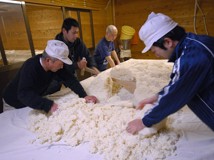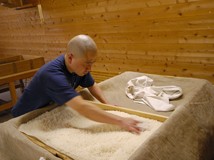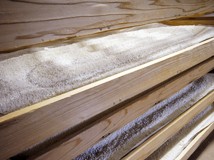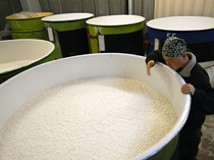An Unsung Hero in the Japanese Diet
Fermented foods and seasonings are so essential to Japanese food that virtually no Japanese meal is complete without them. The beauty of fermentation is that it enhances the flavor of ingredients and increases their nutritional value while at the same time making them less perishable. The Japanese have traditionally made full use of this technique of harnessing microorganisms to produce and preserve diverse foods. At the foundation of this culture are koji in various forms, including rice koji, barley koji, and bean koji .
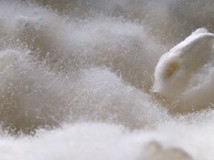
Today, unfortunately, fermented seasonings and foods made using koji face a situation in which "bad money" is on the verge of driving out good. Aimed at producing and preserving foods and beverages, the process of fermentation involves taking vigilant care of living organisms. It is a delicate task that demands much time and close attention. But with the advent of rapid economic growth in the mid-1950s, most of the companies in Japan's food manufacturing industry cast off laborious methods of fermentation and switched to automated fast fermentation under the mantra of "faster, cheaper, and more." Mass production of widely used foods by fast fermentation led to the emergence of national brands in the brewing industry. Inexpensive fermented seasonings, sake, and the like became available anytime, anywhere, and to anyone, but at the cost of the subtle flavors and rich nutrients of naturally fermented products. Things that meant less hassle and less time spent in household duties were welcomed in the home as well.
The pursuit of speed thus penetrated even the area of food, so basic and vital to our lives. The upshot has been a trend away from home cooking, excessive dependence on the food service industries, and changes in the Japanese palate caused by frequent use of chemical additives. These, in turn, have brought on grave changes in Japanese home and local cuisines. Regular consumption of fermented foods has been a factor behind the long life spans that the Japanese enjoy, but this dietary habit is now eroding.
A Secret and Sophisticated Tradition
Given this situation, it seems apropos to turn the spotlight on koji -what it is, how it is made, and how the tradition has been handed down. To begin, a few terms are defined below. The word koji can refer both to a fungus and to a food ingredient that is commonly made using rice, barley, or soybeans.
- Tane koji, literally "seed koji," are the spores of the fungus Aspergillus oryzae . The fungus is a type of mold that is native only to the humid Southeast and East Asian regions.
- Koji is made by sprinkling tane koji over steamed rice, barley, or soybeans and cultivating the fungus under temperature conditions suitable for its growth. As the fungus propagates, enzymes break down the grains' starch and proteins into sugars and amino acids.
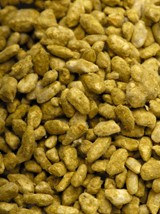
Koji can take on a variety of characteristics depending on what kind of seed koji and grains are used to make them. Different koji are employed for different fermented foods, such as soy sauce, miso, sweet rice wine, vinegar, shochu (a distilled alcoholic beverage), amazake (a sweet, mildly alcoholic drink), and pickles. In fact, even with sake alone, the koji for brewing premium sake and the koji for brewing regular sake are made with distinct types of seed koji, as well as distinct types of rice. Highly polished rice is used for the former and less polished rice for the latter.
Seed koji are distributed in the brewing industry by seed koji dealers, who are versed in the qualities, aptitude, and uses of each. The ancestors of the dealers were the jinnin, who served in shrines. Nearly six centuries ago, in the early Muromachi era (1336-1573), the shogunate exempted these people from a tax that was usually levied on those making koji . The jinnin soon formed a union in Kyoto known as the Koji-za, which enjoyed a monopoly on the production and sale of koji in and around the ancient capital.
Producing and storing seed koji require special skills that have been handed down through the generations in the family business. That knowledge has been kept strictly secret by each dealer, making it exceedingly difficult for other industries and newcomers to enter the business. Consequently, only a dozen or so dealers exist in all of Japan.
Making Rice Koji : A Three-Day Process
For this article, I visited Ishiguro Tane- koji -ten, the sole seed koji dealer in the Hokuriku region (Fukui, Ishikawa, Niigata, and Toyama prefectures). The shop's current owner, Hachiro Ishiguro, makes four different kinds of products: seed koji, rice koji, and miso and amazake made with his own rice koji . The production of seed koji "is an ancestral skill that's been handed down one-to-one, only to the heir of the family business," explains Ishiguro. Others in the trade concur.
Here, therefore, I simply introduce how to make rice koji using seed koji . The process takes about three days.
1. Rice that has been soaked in water overnight is steamed for 40 minutes.
2. After being cooled down, the steamed rice is scarred to facilitate fungal growth, sprinkled with seed koji, and taken into the fermentation room, called koji muro . The rice needs to be cooled because sprinkling the fungi while the rice is still over 45 degrees Celsius will kill them.
It is interesting to note that the temperature of the rice affects the behavior of the koji fungus. The most representative enzyme produced by the fungus is amylase, and the sweetness of amazake, made from rice koji, owes itself to the breakdown of starch into sugar by this enzyme. Amylase is most active when the temperature is between 35 and 40 degrees Celsius. Meanwhile proteases, enzymes that convert proteins into amino acids and draw out the distinct savor of miso and soy sauce, are most active at 30 to 35 degrees. Ishiguro makes separate kinds of rice koji for amazake and for miso by using different temperatures as well as different fungi.
3. The steamed rice is carefully kneaded so that the seed koji spreads evenly throughout the rice. This is called tokomomi . The rice is then gathered into a mound and wrapped in cloth so as to keep it warm.
4. Ten to twelve hours later, temperature and moisture levels within the mound begin to grow uneven as the koji fungi propagate in the steamed rice. To restore uniformity, the mound is broken and carefully mixed by hand, a process called kirikaeshi . The rice is then reshaped into a mound and rewrapped in cloth for insulation.
5. Several hours later, with steady growth of mycelium (filaments), white spots will appear on the surface of the rice. These spots are known as haze and provide an indication of how much the fungi have propagated. The temperature of the rice rises as the fungi proliferate, so the rice is portioned out into small boxes called kojibuta about 10 hours after kirikaeshi . This step is called mori .
6. Five more hours later teire, or mixing the rice by hand, is carried out to relieve the gas generated by fermentation.
7. The kojibuta are covered with straw for insulation. Using straw also allows the developing koji to breathe. The boxes are then stacked on an eight-tier shelf.
8. The temperature and humidity varies depending on where the boxes are placed, so they are shuffled every four or five hours to ensure uniformity, at 12 am and at 4 am.
9. At the end of about two days and nights, the rice koji is complete. Koji with well-grown mycelium is dazzlingly white and fluffy like velvet.
The above process is repeated day and night during the several months from early winter to spring.
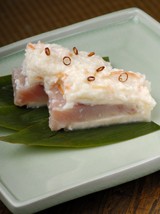
The rice koji produced at Ishiguro Tane-koji-ten is not only used in making amazake and miso at the shop. It is also distributed nationwide as a starter for homemade and factory-made miso and such dishes as kabura sushi . Kabura sushi is a preserved food made by sandwiching yellowtail between turnip slices and pickling this in rice koji for about 10 days. The quality of the rice koji greatly affects the quality of the final kabura sushi, because strong fermentability is needed to draw out the savor of fatty yellowtail. "People around here are all sticklers when it comes to making kabura sushi, as if their lives depended on it," laughs Ishiguro. "So I've got to make my koji as if my life depended on it too."
Recognizing a National Treasure
In 2004 Professor Emeritus Eiji Ichishima of Tohoku University called the koji fungus a "national fungus"-much like national flowers and animals-in the journal of the Brewing Society of Japan, a proposal that was approved at the academic society's annual meeting in 2006. Whether making one's own fermented food or buying it, it is important to choose high-quality koji and foods and beverages made with them. Doing so will help ensure the future of this national asset and the people involved.
It so often happens that we benefit daily from something and yet are oblivious to it precisely because it is so close to our lives. Koji and the culture of fermentation are one such example for the Japanese. Looking back on all the foods that have nourished their people for centuries-and continue to do so-is sure to reveal to the Japanese the sheer wealth of benefits with which koji has provided them.
The production of rice koji, in which seed koji sprinkled over steamed rice propagates and saccharifies the rice, takes about two days and nights.
Rice koji and sake making at Narimasa Brewery
1. Rice koji and sake are usually made during the colder months, but koji fungus propagation is done in a fermentation room warmed to 30-plus degrees. (left below)
2. To promote fungus propagation and saccharification, the rice is placed in small cases and tended around the clock to control temperature and moisture. (right below)
3. The finished rice koji is brought out, a step called dekoji . (left below)
4. Rice koji , steamed rice, yeast, and water are used to brew sake. The contents fermenting in the tank are called moromi . The fermented moromi is pressed to separate the lees and the liquid, yielding sake. (right below)
Fujita, Chieko
Research Adviser
Freelance writer. Has visited many sake breweries in Japan to explore not only the tastes of their products but their unique cultures.
Photos: Kazuo Kikuchi
